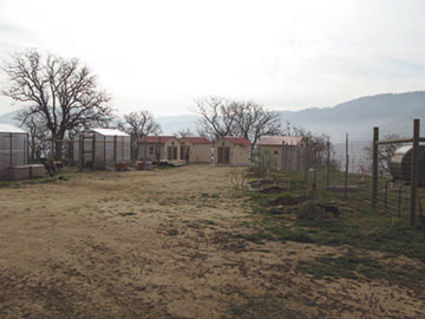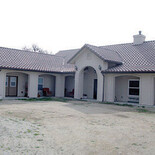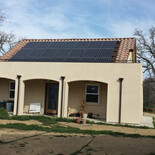The building of an environmentally friendly lifestyle - part 2

Two acres are surrounded with deer fencing, and one of every kind of fruit, nut and berry tree/bush Ann thought that she would use.
In the last issue of The Loop, retired planetary scientist Ann Tovormina shared her dream for a sustainable lifestyle in Tehachapi. Her house was designed and executed to have a low carbon footprint and still be a comfortable home. The last article dealt with the building of the main house which was constructed using passive solar energy as the primary source of heat with the back-up of a masonry stove.
Electricity to the entire property is supplied by active solar panels which are mounted on the roof of the detached 2 car garage. The roof pitch of the garage was set to the latitude of the site to maximize year-round solar electric production. It was fitted with 21 3-feet-by-7-feet panels, which are tied to the electric grid. A rooftop walkway allows dust and dirt to be washed from the panels. The Sunpower inverter control panel shows the kilowatts currently being produced, as well the total kilowatt hours produced that day and since system start up. Ann said that so far it is producing about twice as much as electricity as needed.
The house has a hot water heater that is electric and is attached to a heat pump that can collect warm room air to assist heating the water.
Ann said that she periodically tests for Radon gas, since that can accumulate in homes when the windows are closed for long periods of time. She said this is always a good idea in tight modern homes.
The finished house is approximately 2,600 square feet, which includes her 400 square foot pottery studio. Her kiln will eventually be located in the detached garage.
Once Ann moved into her new home, she was able to think about her orchard and outbuildings. She surrounded two acres with deer fencing and inside planted every kind of fruit, nut and berry she thought that she would use. Every tree is different. She also planted table grapes and wine grapes. She has a hive for mason bees and bumble bees to pollinate the trees, as well as wasps to eat the aphids. Honey bees are due around the first of April. This orchard is in its second year so is not yet bearing fruit. On the north side of her property where the temperature is five to ten degrees colder is a winter orchard containing trees like European plums and pears that need the cooler temperatures.
Outside the orchard, Ann built four outbuildings. The first will be a chicken house, with the chickens soon to arrive.

Outside the orchard Ann built four outbuildings. A chicken coop, milkshed, garden shed and an animal supply shed.
The second building is planned to be a milk shed and honey processing with a pen marked off for the goats, which are also due soon. The third and fourth buildings are for gardening and animal supplies. There are also three greenhouses, which Ann purchased from Santa Barbara Greenhouses. She has planted them with citrus trees, winter vegetables and strawberries. The relatively lightweight greenhouse panels have been reinforced to withstand the wind. They are thermostatically controlled and have a mister and fans controlled by a timer.
Every detail of Ann's beautiful and practical home has been meticulously planned. She says for anyone with an existing home who wants to use less fossil fuel and save energy, look into solar panels, augment attic insulation, and plant shade trees on the east and west side of the house. For more photos and information, please check out Ann's website at lightupontheearth.wordpress.com.
A big thank you to Ann for the educational tour given to The Loop.










